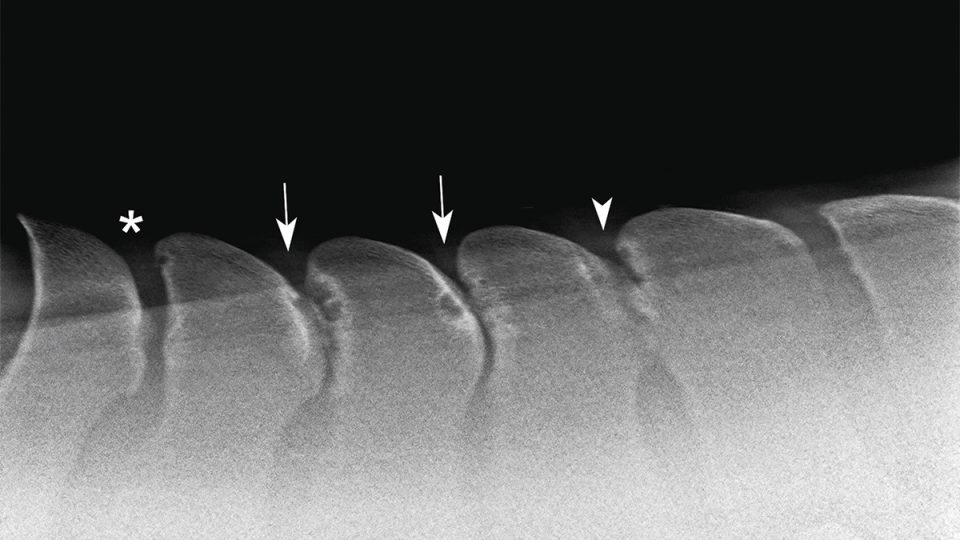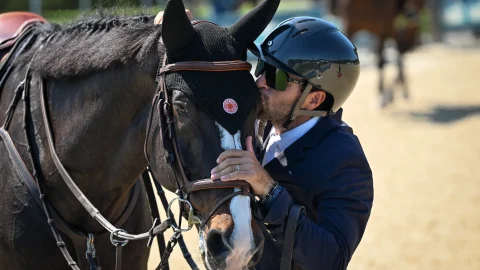In the world of dressage, where the harmony between horse and rider depends on suppleness, balance, and correct engagement of the back, few conditions are as misunderstood — or feared — as kissing spines.
Yet this diagnosis is not always a death sentence for a career. Understanding what it really means is the first step toward prevention, management, and in many cases, recovery.
What Are “Kissing Spines”?
The term kissing spines refers to a condition formally known as overriding dorsal spinous processes (ORDSP).
It occurs when the bony projections along the top of the horse’s vertebrae (usually in the thoracic region, often between T13 and T18) come too close together or touch each other.
In severe cases, they may even rub, causing inflammation, pain, and muscular tension.
In simple terms: the bones of the spine that should have space between them begin to “kiss” — and that contact triggers a cascade of compensations in the horse’s way of going.
Why Dressage Horses Are Particularly at Risk
Dressage training asks the horse to lift its back, engage the hindquarters, and round through the topline — biomechanically demanding tasks. If the horse is not conditioned correctly, or if the rider’s aids cause tension rather than elasticity, pressure on the thoracic vertebrae may increase.
Some of the risk factors include:
- Starting training too intensely before full skeletal maturity
- Riding in excessive collection too early or for too long
- Poor saddle fit, which causes uneven loading on the back
- Misuse of the reins (pulling, inconsistency) that leads to a hollow back
- Conformation traits (e.g. short backs, higher withers) that predispose to spinal contact
Recognizing the Signs
The clinical presentation can vary widely. Some horses show overt pain; others quietly lose performance. Common signs include:
- Reluctance or sensitivity when being saddled or mounted
- Stiffness, especially in transitions or lateral work
- Difficulty maintaining impulsion through the back
- Sudden drop in topline muscle or topline engagement
- “Cold-backed” behavior, bucking, or resistance at the start of work
- Changes in attitude, unwillingness, or decline in rideability
It’s essential to interpret behavior as communication — pain changes biomechanics and thus the mind.
Diagnosis: Beyond the X-Ray
Radiographs (X-rays) are essential to confirm the presence of touching or closely approximated spinous processes. But imaging alone doesn't tell the full story: some horses have significant changes on film yet no symptoms, while others with minor radiographic evidence are in real discomfort.
The ideal diagnostic approach is a triangulation of:
- Clinical examination by a specialist equine veterinarian
- Diagnostic imaging (radiographs, possibly ultrasound or advanced imaging)
- Ridden evaluation — watching how the horse moves under saddle or in hand
This combined assessment helps avoid overdiagnosis or underestimating the issue.
Treatment and Rehabilitation
The encouraging truth is that many horses with kissing spines can return to full function — even to high-level dressage — with appropriate management.
Conservative (Non-surgical) Approaches
These are often first-line and may be sufficient:
- Physiotherapy / Equine osteo / chiropractic to restore mobility, symmetry, and muscle balance
- Targeted exercises to strengthen the thoracolumbar system and adjust musculature
- Shockwave therapy, mesotherapy, or other modalities to address local inflammation
- Perfect saddle fit (or re-fitting) to remove pain or pressure sources
- Correct dressage training:
- Emphasize stretching, long-and-low frames early
- Gradual acceptance of contact, lateral work, transitions
- Avoid overdrilling or excessive collection too soon
- Strategic rest days, turnout, and cross-work to support recovery
Surgical Options
If conservative therapy fails and clinical signs persist, surgery may be considered. Common procedures include:
- Interspinous ligament desmotomy (cutting the ligament between the spinous processes)
- Partial resection of one of the contacting spinous processes
With advances in veterinary surgery, the procedures are less invasive than in the past, and many horses do very well post-op when rehabilitation is properly managed.
Dressage Philosophy and Prevention
Prevention is always better than cure. The dressage rider’s job is to work in harmony with biomechanics, not against it.
Some guiding principles:
- Develop topline strength before demanding collection
- Use transitions, lateral exercises, and supple schooling to maintain elasticity
- Alternate schooling days with hack, stretching, or loosening work
- Avoid repetitive, high-stress movements day after day
- Schedule regular checks: vet, saddle fitter, physiotherapist
In dressage, the back is the bridge between power and expression. When we lose the back, we lose the art.
Recommended Video
Understanding Kissing Spine (Dr. Magda Stewart)
This video features Dr. Magda Stewart from Equine Sports Medicine, who explains what occurs anatomically in a horse with kissing spines, discusses diagnosis, and outlines treatment options. It’s clear, informative, and well-suited to riders wanting a deeper understanding.
Conclusion
Kissing spines is not just a veterinary term — it’s a reminder that performance and health depend on the quality of training.
Patience, correct technique, and respect for the horse’s biomechanics remain the best preventive medicine.
At Gallery Horse, we believe that knowledge is the foundation of good horsemanship.
Understanding your horse’s back means caring for its well-being and its future as an athlete.





